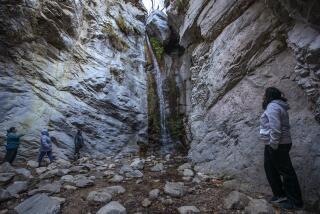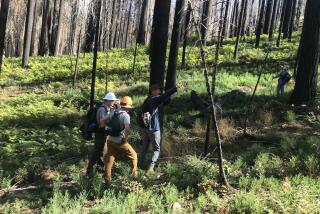U.S. tightens limits on cutting timber in Sequoia Monument

A new management plan for the Giant Sequoia National Monument places greater limits on timber cutting in and near groves of the world’s largest trees, but would still allow logging in nearly a quarter of the monument.
The plan, released Tuesday by the U.S. Forest Service, is the agency’s latest attempt at devising a blueprint for managing the 328,000-acre monument, which President Clinton created in 2000 to protect 34 groves of giant sequoias scattered on the slopes of the southern Sierra Nevada in the Sequoia National Forest.
Although the monument designation bans commercial logging, that didn’t stop the Forest Service from issuing a plan in 2004 that would have allowed enough timber cutting in the monument to fill more than 2,000 logging trucks a year — all in the name of reducing the risk of wildfire.
Conservationists sued the agency, accusing it of trying to assuage the local timber industry. Calling the 2004 plan “incomprehensible,” a federal judge tossed it out, ordering the Forest Service to draw up a new one.
Sequoia National Forest Supervisor Kevin Elliott, who oversees the monument, said the new blueprint strikes a balance, calling for the use of mechanical tree thinning and managed fire to restore forest health and encourage regeneration of giant sequoias, which are found in the wild only on the western slopes of the Sierra.
Although the new plan reduces the size of trees that can be felled, it allows the cutting of some young sequoias, no larger than a foot in diameter, and other trees as big as 20 inches in diameter to reduce fuel loads and promote ecological restoration. Any young sequoia trees that were felled would not be sold, the agency said. But other conifers and trees could be. The diameter limit would also not apply to trees considered a hazard along roads or in public areas.
“I still think it’s a logging plan,” said Ara Marderosian, executive director of Sequoia ForestKeeper, a conservation group that has long criticized the way the Forest Service manages its sequoia groves. “The most flammable things are the brush and small fuels — not trees up to 20 inches in diameter.”
Giant sequoias can grow as tall as a skyscraper and live to be several thousand years old. They depend on wildfire for regeneration as their small cones open with the heat, releasing showers of seeds. Fire also creates small, sunny openings that promote sapling growth.
The Forest Service’s long policy of fire suppression has been blamed for the decline of the sequoia groves. In the nearby Sequoia and Kings Canyon National Parks, managers primarily use prescribed burns to create sequoia-friendly conditions.
Conservationists want the Forest Service to adopt the U.S. Park Service approach. But Elliott said that “fire alone is not going to fit the bill. Mechanical treatments are appropriate.” The many private holdings and small communities scattered across the forest demand more aggressive fuel reduction, he added.
Sequoia ForestKeeper has argued that the agency used the hazard tree provision to cut down commercially valuable old non-sequoias in 2005, when it removed about 200 trees near the popular Trail of 100 Giants and sold 67 of them as timber. Judging by the number of rings on the stump, Marderosian said one of the felled trees was 320 years old.
According to documents released Tuesday, mechanical tree thinning would be allowed on about 23% of the monument acreage. But Sierra Club staff attorney Kristin Henry said other provisions in the plan could potentially open the door to tree cutting on much more land.
“I’m just a little bit skeptical,” Henry said. “It seems as though this plan is geared to a lot of logging.”
The plan also recommends the designation of a 15,110-acre wilderness area in the southern portion of the Moses roadless area and the creation of two special interest areas in the monument, the 4,190-acre Freeman Creek Grove Botanical Area and the 3,500-acre Windy Gulch Geological Area, which contains a number of caves with Pleistocene-era fossils.
The areas would be managed to protect their unique characteristics.
More to Read
Start your day right
Sign up for Essential California for news, features and recommendations from the L.A. Times and beyond in your inbox six days a week.
You may occasionally receive promotional content from the Los Angeles Times.







